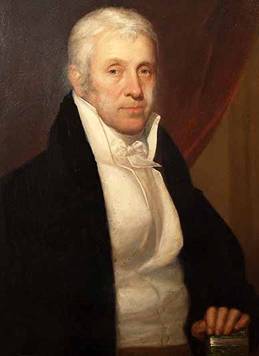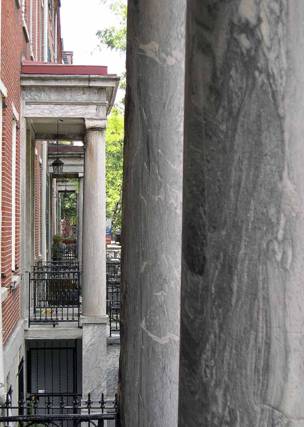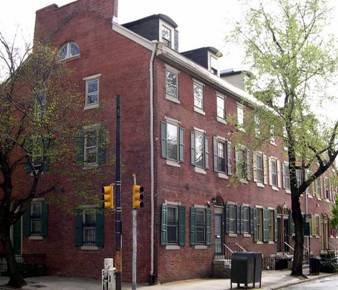Location, Location
Houses in uncountable hundreds became the signature construction of Company members. An early example is the home of Isaac Zane, a founding member of the Carpenters' Company. Zane, a leader in establishing Quaker schools, lived in this tiny house in Elfreth's Alley — the city's oldest street — with his wife, six children and two apprentices. He died in 1790, the year Philadelphia once again became the nation's capital.
Until well after the Civil War, houses continued to stand, shoulder-to-shoulder, in horizontal rows. New construction techniques then enabled residences to be stacked vertically, one atop the other. Today, condo towers erected by Company members are more than double the height of early apartment houses.
Below is a sampling of builders — and their works — which have led Philadelphia to be known as "the city of homes."
1750 – Without doubt, Samuel Rhoads was among the most gifted master builders of the colonial city. More than a "carpinter-builder," as he once described himself, Rhoads became a wealthy real estate speculator, often purchasing farmland he later sub-divided then sold for building lots. By middle age, such business acumen enabled him — like his friend Benjamin Franklin — to devote himself to Revolutionary politics and new institutions, both charitable and educational.
Of the mansions and homes Rhoads constructed, only the one built for his family at 217 Delancey St. survives. In eight years, he sold it to the newly appointed controller of the Port of Philadelphia, Alexander Barclay. More than two centuries later (in July, 1976, to be exact) President Gerald L. Ford stayed here during his Bicentennial visit.
Pennsylvania Hospital on Spruce St. between 8th & 9th Sts. is Rhoads's masterpiece. Although he lived to see only the east wing constructed (1755-57), later builders largely followed his design.
In 1741,thirty some years before the Revolution, Rhoads became a member of the Common Council and an ally of Franklin. Years later, Rhoads and Robert Smith built Franklin's house. Election to the Pennsylvania Assembly representing Philadelphia came in 1761; re-election nine years later.
1774 was Rhoads's big year. First, he was chosen speaker of the revolutionary Provincial Assembly; then a delegate to the First Continental Congress (the only Carpenters' Company member present.) Finally, on October 4th, while the Congress was in session, he became the 77th mayor of Philadelphia to serve a one-year term. It would be more than a century (in 1887) before mayors filled the office for four years.
The Union Fire Company, The Philadelphia Contributionship, The American Philosophical Society, The Library Company of Philadelphia, and Pennsylvania Hospital all count Rhoads as a founder or a director. He died in 1784 while serving as Master (president) of the Company.
1800 – One of the city's less celebrated "firsts" is introduction to America of the rowhouse. Just prior to the new century, William Sansom bought at sheriff's sale the property and unfinished house of Robert Morris, on Walnut St. between 7th and 8th Sts. He promptly bi-sected the land with a new east-west street bearing his name. Thomas Carstairs, not yet a Company member, purchased the south side of Sansom St. and erected (as shown in the elevation he drew) 22 look-alike dwellings. Until then, houses had been built in rows, but individually. A growing city demanded mass production. Several of his buildings survive, greatly altered, along "jewelers' row."
The Library Company of Phladelphia
Carstairs arrived from London 16 years earlier, brash and talented. In the "Philadelphia Packet" of February, 1784, Carstairs advertised "he intends to follow his profession in all its various branches. Being regularly bred to it... he flatters himself he will give every satisfaction to such gentlemen as please to employ him." The same year he petitioned the Carpenters' Company for membership. Despite his Scottish ancestry, Carstairs was rejected as a "foreigner." So much for honoring the memory of the Company's most famous Scot, Robert Smith, architect of Carpenters' Hall.
courtesy:
The Chester County Historical Society
Despite this snub, commissions quickly followed. For a prestigious men's dinner club on the Delaware river at Andalusia he designed "The Castle," their meeting place. For Thomas Jefferson's house on Market St., Carstairs included a solarium and an alcove bed the secretary of state liked so well he incorporated it at Monticello. In 1793, at the age of 34, Carstairs served on a committee — chaired by Jefferson — to review plans for the capitol building in the new federal city, Washington. Earlier, he won second prize for The Library Company's new building, following their decision to move from Carpenters' Hall.
Thomas Carstairs could be ignored no longer. In 1788 the Company elected him to membership. This time he rejected them. Not until 1804, after the Sansom St. houses were a financial success, did Thomas Carstairs accept the Company's invitation.
1830 – All things British fell from favor with the bitterly fought War of 1812 — more accurately known as the Second War for Independence. The imposing elegance of Greek Revival, an architectural style born in Philadelphia, became the new fashion. No public building could be without stately columns. Nor could mansions in the North or on southern plantations. Portico Row, on Spruce St. between 9th and 10th Sts., is the sole survivor of Greek revival applied to row housing. A chief disciple of the new fashion was a Philadelphia-born architect, Thomas U. Walter. John Savage, who owned the land, paid the 24-year-old Walter $30 to design a row of sixteen up-scale dwellings. Several builders completed the structures and sold them, with interiors incomplete, to new owners. They, in turn, decorated rooms according to their tastes, and pocketbooks. Some were lavish indeed: doors of three-inch-thick Honduran mahogany; door knobs of cut crystal; silver-plated hardware; balusters of bird's-eye maple supporting mahogany railings continuous from first to third floors.
Luckily, Robert O'Neill purchased a lot near Portico Row's western end and erected number 926. Otherwise, his construction record would be blank. One of two sons of Carpenters' Company John O'Neill, Robert (elected 1820; deceased 1874) appears in city directories as a "house carpenter," later as a fire insurance company surveyor. Presley, his older brother and also a Company member, decided to open a hardware store near 6th and Market Sts.
Thomas U. Walter achieved architectural greatness. In 1833 — three years after Portico Row — he designed the pinnacle of Greek Revival, Founder's Hall at Girard College. Later, Walter was chosen as the architect for the two wings and dome of the Capitol, in Washington, D.C.
1830 – A half mile west of Portico Row, at 13th and Lombard Sts., stands a row of six houses whose provenance is more intriguing than their traditional appearance. In 1779, two years before Yorktown, Philadelphia desperately needed housing for an expanding city. Descendants of William Penn had fled to England but still held title to most of the land from the city's western boundary, Washington Square, to Rittenhouse Square. Moreover, they refused to sell, hoping for higher post-war prices. Pennsylvania faced its own crisis, a war debt of 132,000 pounds and mounting.
With passage of the "Diversity Act," the Assembly hoped to relieve both headaches. Penn lands were confiscated, then auctioned to speculators for re-sale to builders. Two years later all lots had been sold; Pennsylvania undershot its goal by 4,000 pounds.
Lots bordering both Lombard and 13th Sts. passed through three owners before George Harmstad broke ground in 1830. Harmstad, elected to the Carpenters' Company two years earlier, purchased the land from the Linnard brothers, owners of a thriving lumber yard at 11th and Pine Sts. Thomas Linnard was a Company member and probably also sold Harmstad building materials. Just north of the corner Harmstad erected for a "ladies shoemaker" a high-ceilinged Victorian style house, one of the area's first. Later he lived there.
Harmstad's grandparents settled in Nova Scotia in 1752, on their arrival from Hamburg, Germany. Five years later they moved to Philadelphia during the forced exodus of French-speaking Nova Scotians. Had they wished, George and his seven brothers could have made house-building a family affair. Three were carpenters, one a marble merchant, a bricklayer, a stone cutter and a cabinetmaker. Harmstad died in 1863, the climactic year of the Civil War and the Battle of Gettysburg.
C.G.K.





